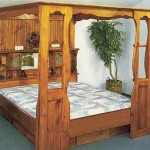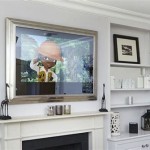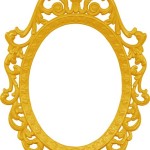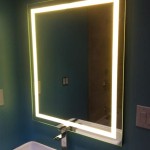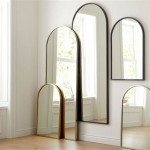How To Know If A Mirror Is Double Sided Or Not
Determining whether a mirror is one-way or two-way (often referred to as "double-sided," though this term isn't technically accurate) can be crucial for privacy and security reasons. While true two-way mirrors are less common than their portrayal in popular media, observation mirrors designed for surveillance do exist. This article outlines several methods for identifying the nature of a mirror.
The Fingernail Test
One commonly cited method is the fingernail test. This involves placing a fingernail directly against the reflective surface of the mirror. With a standard, first-surface mirror, a small gap will be visible between the nail and its reflection due to the glass layer present. However, with a two-way mirror, often constructed with a second-surface mirror, the reflection appears to touch the fingernail directly. This is because the reflective coating is applied behind a layer of glass, minimizing the gap. While often used, this test is not entirely reliable as the quality of the glass and coating can influence the perceived gap.
The Light Test: Examining Light Transmission
A more reliable approach involves examining the mirror's light transmission properties. Two-way mirrors function by allowing a percentage of light to pass through while reflecting the rest. This difference in light transmission can be exploited for identification. Find a darkened room and hold a bright flashlight against the mirror's surface. If light bleeds through, indicating some degree of transparency, the mirror is likely a two-way mirror. A standard mirror reflects almost all light, minimizing light penetration.
Observing the Surroundings: Environmental Clues
The environment in which the mirror is located can also offer telling clues. Consider the following: *
Discrepancies in Lighting:
Is the area behind the suspected mirror significantly brighter or darker than the area in front? A brighter area behind the mirror might indicate an observation room. *Presence of Hidden Cameras or Microphones:
Look for small holes or other irregularities around the mirror's frame or nearby walls that might house hidden surveillance equipment. *Unusual Wall Construction:
Does the wall containing the mirror appear thicker than other walls in the area? This could be concealing a hidden observation space.The Sound Test: Checking for Sound Transmission
Similar to the light test, sound can be employed to check for differences in transmission. Gently knock on the mirror's surface and listen carefully. A two-way mirror, being thinner than a standard mirror due to its construction, may produce a hollow, slightly reverberating sound. A standard mirror, with its thicker glass layer, will usually produce a duller thud. However, this test can be influenced by the wall's construction and may not always be definitive.
Viewing Angle Manipulation: Shifting Perspectives
This method involves attempting to see through the mirror by manipulating the viewing angle and ambient light. Try cupping your hands around your eyes to block out reflections and peering through the mirror at an oblique angle. If the area behind the mirror becomes slightly visible, this suggests the mirror allows some light transmission, indicative of a two-way mirror.
The Coin Test: Examining Surface Construction
The coin test is a variation of the fingernail test. Place a coin flat against the mirror surface and observe its reflection. Similar to the fingernail test, if a gap is visible between the coin and its reflection, it is likely a standard, first-surface mirror. If the reflection appears to directly touch the coin, it could be a second-surface mirror, potentially used in a two-way configuration.
Seeking Professional Assistance
If doubts persist after employing these methods, seeking the assistance of a security professional or glazier is recommended. They possess the expertise and specialized equipment to definitively determine the mirror’s nature. This is particularly crucial in sensitive environments where privacy is a primary concern. They can employ more sophisticated techniques to analyze the mirror's reflection and transmission properties, providing conclusive results.
Considering the Context: Location and Purpose
Finally, consider the context of the mirror's placement. Two-way mirrors are typically used in specific settings, such as security observation rooms, interrogation rooms, and some research facilities. If the mirror is located in a public restroom, dressing room, or other area where privacy is expected, the probability of it being a two-way mirror is significantly lower. However, vigilance is always recommended, and relying solely on context without further investigation is not advised.
Combining Methods for Enhanced Accuracy
It is crucial to understand that no single test is foolproof. The most effective approach is to combine multiple methods described above. For example, coupling the fingernail test with the light test and observing the surrounding environment can provide a more accurate assessment. The more tests that point towards a two-way mirror, the higher the likelihood of its presence.

Mirror Or Two Way Glass Here S How To Tell The Difference Test Safety

How To Tell If A Mirror Is Two Way Or Not Quora

How To Tell If A Mirror Is Two Way Or Not 8 Steps With Pictures Hotel Mirrors Double Sided

How To Tell If A Mirror Is Two Way Or Not 8 Steps With Pictures

How To Tell If A Mirror Is Two Way Or Not 8 Steps With Pictures
How To Tell If A Mirror Is Two Way Or Not Quora

Tips For Identifying Whether Your Mirror Is Two Way Or Not Ledmyplace

How To Tell If A Mirror Is Two Way Or Not 8 Steps With Pictures

Touch Your Mirror To Know If Someone S Watching You

How To Check If Mirror Is One Way Or Two

